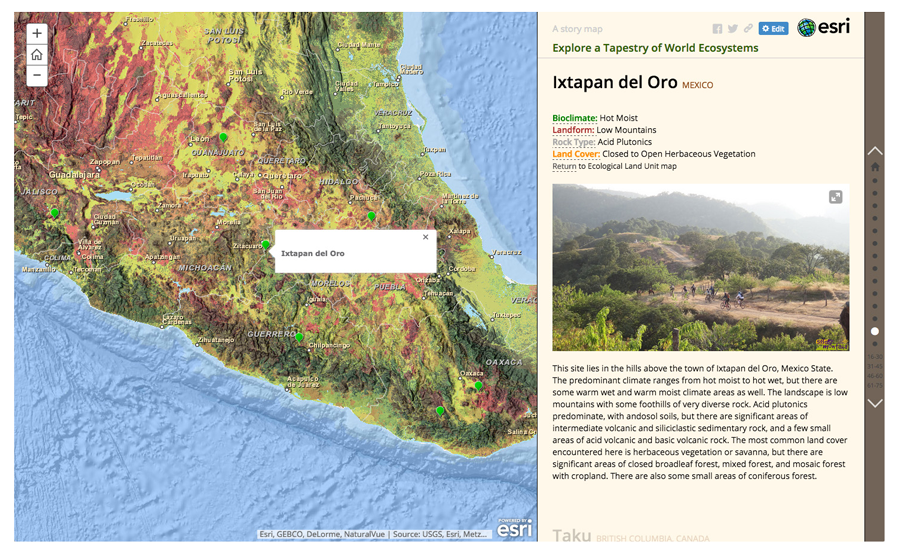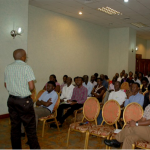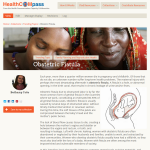Harnessing the Power of Digital Storytelling Webinar Recap
HC3’s eighth Health Communication Innovation Webinar held March 10 focused on digital storytelling techniques to enhance health communication campaigns.
Moderator Jessica Weitzel, Director of Evaluation at Via Evaluation, opened the session with insight into the power of storytelling as a means to influence and accelerate behavior change.
“Storytelling is something that has helped connect people throughout history, and more importantly, throughout cultures,” she said. “By harnessing digital tools and technology, storytellers can strengthen and tailor their message and better reach and connect with their audience in more ways than ever before.”
Telling a Story with Video
Matthew York, founder and executive director of One Mobile Projector Per Trainer (OMPT), shared his team’s approach to storytelling via videography. OMPT works to educate, inspire and mentor those around the world wanting to embrace video, and serves a range of sector areas including agriculture, civil society, education, health, sanitation and hygiene.
OMPT follows an “LOCP” philosophy – local origination, cordless projection. York and his team encourage organizations to produce video locally, using local languages and culturally relevant material.
“We believe videos should originate as close to the beneficiary population as possible so they can identify with those featured, making the video more believable and more credible,” shared York.
These videos are then distributed and shared via cordless projection – battery powered video projectors – to increase reach. OMPT provides instruction on simple production styles and mediated instruction during viewing; in ideal environments, video projectors are loaned to local residents who facilitate the education.
“We conduct four-day video education workshops with help from local video trainers. Once we depart, they’re there to provide sustainable, ongoing presence and support,” said York.
Telling a Story with Maps
Digital maps are an alternative, up-and-coming way to use the power of geography to organize and tell stories. Allen Carroll, program manager for storytelling at Esri, has developed an array of open-source web apps that enable thousands of people to tell their own place-based stories using interactive maps and multimedia content.
Most story maps incorporate builder functions that allow users to create a sophisticated story without any GIS or web development skills. Esri hosts story maps in the cloud (although users can opt to host them independently). Most apps work equally well on all screen sizes – whether PC, laptops, tablets and smartphones.
Carroll discussed two specific sequential narrative examples: story map tours and story map journals.
Story map tours string together a series of geo-tagged photos or videos into a narrative. This platform is well suited for travelogues and walking tours, as it places an emphasis on good visuals and is light on text.
Story map journals can host a richer mix of multimedia content and much longer text. What they call the “main stage” features interactive maps, images, video and web pages and a side panel with text, photos and videos. This format is ideal for text-based narratives and presenting GIS results. The World Health Organization (WHO) uses story map journals on a regular basis to summarize progress in their effort to eradicate the West Africa Ebola outbreak.
“These [apps] are flexible and powerful tools that allow you to put together really cool stories without any technical expertise. It’s been exciting to us to see how many organizations (lots of them NGOs) are using these tools to tell all sorts of different stories,” said Carroll.
To download these apps, visit storymaps.arcgis.com – all are free with a public or subscription ArcGIS online account.
The Power of First-person and Participatory Media
After learning about some practical applications from York and Carroll, Amy Hill, co-founder and director of Silence Speaks, delved into some of the finer mechanics, methods and approaches behind effective digital storytelling.
Silence Speaks is an international digital storytelling initiative that has employed oral history, facilitative filmmaking and popular education strategies to support the telling and public sharing of life stories documenting injustice and promoting change.
Hill defines storytelling as “a unique blend of first-person voice storytelling processes and participatory media.” According to Hill, first-person stories can be especially powerful tools for public health work in their universality, intimacy, honesty and undemanding nature.
“The real voice and words of an individual can touch hearts in a way that facts and figures just can’t… First-person stories, when told well, can have a really strong quality of honesty. They don’t exploit or sensationalize, and they don’t tell us what to do,” she said.
Hill also made the case for the use of participatory media in public health. Community-based participatory media is a diverse and collaborative process that brings people together in the creation and analysis of media. According to Hill, it is more democratic because it is shaped by the voices of many rather than by “expert” trained professionals; it honors storytellers by letting them decide how to share their own experiences.
Through her work with Silence Speaks, Hill has partnered with local and national government agencies, private foundations and UN agencies to develop and carry out participatory media projects around the world. Although there is little research on the impact of digital storytelling in public health given its status as a relatively new methodology, there are still some qualitative studies that reveal the positive impact of participatory media, like this article on the effect of participatory media in several Silence Speaks projects.
Hill highlighted a few additional case examples of how public health practitioners are sharing stories to create change:
- In individual and community education. In Nepal, Silence Speaks partners are using young women’s stories to educate women on their rights under the countries laws related to gender-based violence.
- As part of provider training. In Uganda, EngenderHealth integrated women’s personal stories into provider training on obstetric fistula repair and prevention. View stories from this project.
- For social norm change. In South Africa, the Sonke Gender Justice Network shares digital stories as part of its one-man-can campaign to shift social norms about gender and men’s violence and as part of its community mobilization training.
- In policy advocacy. Marie Stopes International is preparing to position youth stories from Papa New Guinea and Ghana within their efforts to change institutional and public policy to create greater opportunities for adolescent sexual and reproductive health and well-being.
View selected stories created in Silence Speaks Workshops:
- Water Rights in Central Asia ( https://www.youtube.com/watch?v=p3_pLKdoasw )
- Indigenous Women and Education in Latin America ( https://www.youtube.com/watch?v=Z_D9arQ-4WU )
- Gender-Based Violence in Sub-Saharan Africa ( https://www.youtube.com/watch?v=EiIb1VCvN2c )
Want to continue the conversation? Visit Springboard with questions or ideas and keep the discussion going.
Download the Presentations and Listen to the Recording
This webinar is the latest in an ongoing series produced over the past year and a half by the Health Communication Capacity Collaborative (HC3), a five-year global project funded by USAID and led by Johns Hopkins Center for Communication Programs in partnership with Management Sciences for Health, NetHope, Population Services International, Ogilvy Public Relations, Internews and Forum One Communications. HC3’s main objective is to strengthen capacity to design, implement and evaluate state-of-the-art social and behavior change communication programs. The Innovation Webinar Series works to help achieve this objective by spotlighting a broad range of health communication innovations and engaging a diverse audience around a meaningful mix of theory and practical examples, drawn from academic, public and private sectors.








Leave a Reply
Want to join the discussion?Feel free to contribute!